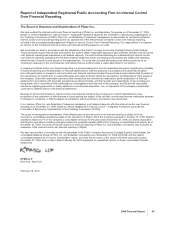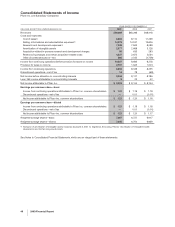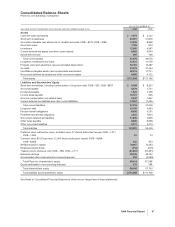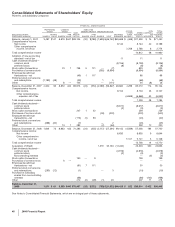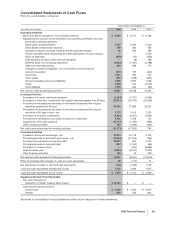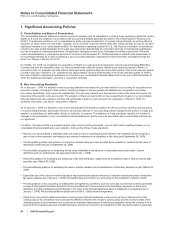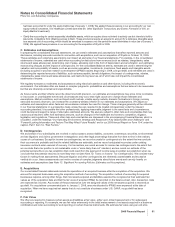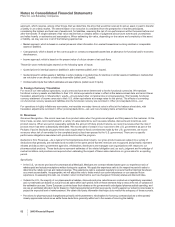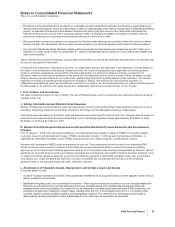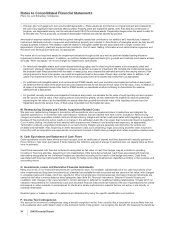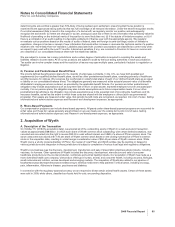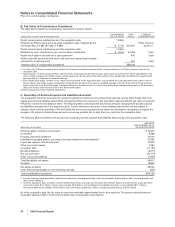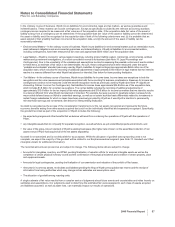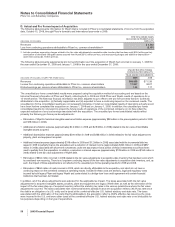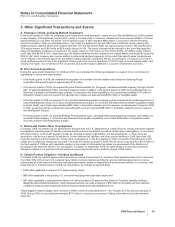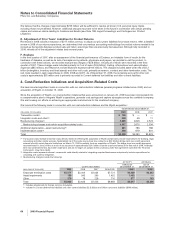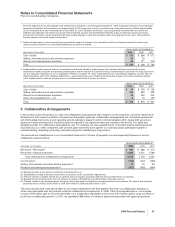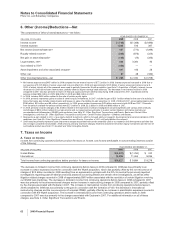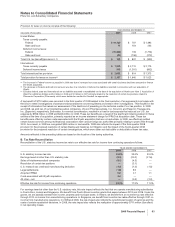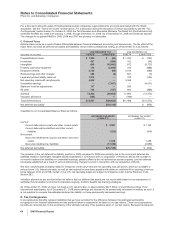Pfizer 2009 Annual Report Download - page 57
Download and view the complete annual report
Please find page 57 of the 2009 Pfizer annual report below. You can navigate through the pages in the report by either clicking on the pages listed below, or by using the keyword search tool below to find specific information within the annual report.
Notes to Consolidated Financial Statements
Pfizer Inc. and Subsidiary Companies
determining the amount that is greater than 50% likely of being realized upon settlement, presuming that the tax position is
examined by the appropriate taxing authority that has full knowledge of all relevant information. Under the benefit recognition model,
if our initial assessment fails to result in the recognition of a tax benefit, we regularly monitor our position and subsequently
recognize the tax benefit: (i) if there are changes in tax law, analogous case law or there is new information that sufficiently raise the
likelihood of prevailing on the technical merits of the position to more likely than not; (ii) if the statute of limitations expires; or (iii) if
there is a completion of an audit resulting in a favorable settlement of that tax year with the appropriate agency. We regularly
re-evaluate our tax positions based on the results of audits of federal, state and foreign income tax filings, statute of limitations
expirations, changes in tax law or receipt of new information that would either increase or decrease the technical merits of a position
relative to the “more-likely-than-not” standard. Liabilities associated with uncertain tax positions are classified as current only when
we expect to pay cash within the next 12 months. Interest and penalties, if any, are recorded in Provision for taxes on income and
are classified on our consolidated balance sheet with the related tax liability.
We are subject to income tax in many jurisdictions and a certain degree of estimation is required in recording the assets and
liabilities related to income taxes. All of our tax positions are subject to audit by the local taxing authorities in each tax jurisdiction.
Tax audits can involve complex issues and the resolution of issues may span multiple years, particularly if subject to negotiation or
litigation.
Q. Pension and Postretirement Benefit Plans
We provide defined benefit pension plans for the majority of employees worldwide. In the U.S., we have both qualified and
supplemental (non-qualified) defined benefit plans, as well as other postretirement benefit plans, consisting primarily of healthcare
and life insurance for retirees. We recognize the overfunded or underfunded status of each of our defined benefit plans as an asset
or liability on our consolidated balance sheet. The obligations generally are measured at the actuarial present value of all benefits
attributable to employee service rendered, as provided by the applicable benefit formula. Our pension and other postretirement
obligations may include assumptions such as long-term rate of return on plan assets, expected employee turnover and participant
mortality. For our pension plans, the obligation may also include assumptions as to future compensation levels. For our other
postretirement benefit plans, the obligation may include assumptions as to the expected cost of providing the healthcare and life
insurance benefits, as well as the extent to which those costs are shared with the employee or others (such as governmental
programs). Plan assets are measured at fair value. Net periodic benefit costs are recognized, as required, into Cost of sales, Selling,
informational and administrative expenses and Research and development expenses, as appropriate.
R. Share-Based Payments
Our compensation programs can include share-based payments. All grants under share-based payment programs are accounted for
at fair value and these fair values generally are amortized on an even basis over the vesting terms into Cost of sales, Selling,
informational and administrative expenses, and Research and development expenses, as appropriate.
2. Acquisition of Wyeth
A. Description of the Transaction
On October 15, 2009 (the acquisition date), we acquired all of the outstanding equity of Wyeth in a cash-and-stock transaction,
valued at approximately $68 billion, in which each share of Wyeth common stock outstanding, with certain limited exceptions, was
canceled and converted into the right to receive $33.00 in cash without interest and 0.985 of a share of Pfizer common stock. The
stock component was valued at $17.40 per share of Wyeth common stock based on the closing market price of Pfizer’s common
stock on the acquisition date, resulting in a total merger consideration value of $50.40 per share of Wyeth common stock. While
Wyeth now is a wholly owned subsidiary of Pfizer, the merger of local Pfizer and Wyeth entities may be pending or delayed in
various jurisdictions and integration in these jurisdictions is subject to completion of various local legal and regulatory obligations.
Wyeth’s core business was the discovery, development, manufacture and sale of prescription pharmaceutical products, including
vaccines, for humans. Other operations of Wyeth included the discovery, development, manufacture and sale of consumer
healthcare products (over-the-counter products), nutritionals and animal health products. Our acquisition of Wyeth has made us a
more diversified health care company, with product offerings in human, animal, and consumer health, including vaccines, biologics,
small molecules and nutrition, across developed and emerging markets. The acquisition of Wyeth also added to our pipeline of
biopharmaceutical development projects endeavoring to develop medicines to help patients in critical areas, including oncology,
pain, inflammation, Alzheimer’s disease, psychoses and diabetes.
In connection with the regulatory approval process, we are required to divest certain animal health assets. Certain of these assets
were sold in 2009, while others, classified as Assets held for sale, are pending disposition.
2009 Financial Report 55


